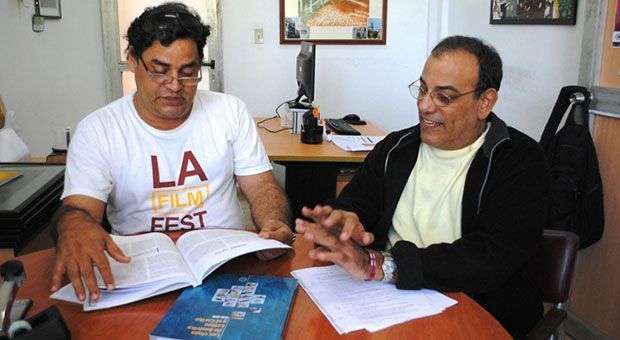The first story of the evolution of film industries in Latin America and the Caribbean published in Cuba and perhaps the most comprehensive to date, was presented this Thursday at the Casa del Alba, in the framework of this International Book Fair Cuba 2014.
Under the title “The cinemas of Latin America and the Caribbean” this sort of two-volume Encyclopedia is an unprecedented text that tries to give an overview of just over a century of cinema in Latin America and the Caribbean, emphasizing the similarities between different national industries.
Coordinated by the critic and researcher Edgar Soberon Torchia the book published by Editions EICTV , is also is the first publication of the International School of Film and Television of San Antonio de los Baños that will have a national scope.
According to critic Joel del Rio, one of the principal drafters, they insisted all along that it was not a story of hegemonic Latin American cinema, nor that Cuban film would prevail because it had been created here.
The priority was to serve a historiographical tour, especially to students of film schools on the continent, to recognize the development of Latin American film industries, but being a highly readable text, that might appeal to the general public, Soberon said exclusively to OnCuba .
So far, Joel del Rio said, there is no other similar to this endeavor, at least that we know of, to collect so many important events, except maybe a multi-volume encyclopedia of Latin American filmmakers, made in Spain and available at high prices. But, there is no another volume of such importance from our region, he said.
Soberon Torchia had the idea to build this over twenty years ago, writing “A century of cinema, a history of world cinema,” published in Mexico. But at that moment it was not possible and it was not until 2009 that he begins to work on the project, following a suggestion from the academic direction of EICTV.
From that moment, both researchers labored alongside Luciano Castillo in the making of “The Bible of Latin American cinema,” as it was nicknamed, and organized collaborations of more than 50 experts from the region, who wrote for it without making a dime.
That way the current structure of theaters in Latin America and the Caribbean, consisting of articles and reprints where emphasis is placed on certain filmmakers, actors, films or high points of these cinemas. The chapters are divided by decades, except for the 30s and 40’s which were put together because they are regarded as the golden age of cinema in Latin America and the Caribbean.
“Finally, the two volumes fructify with the support of the Cuban Book Institute, who took over the printing of 2800 copies, just when it seemed that the only solution would be to turn it into an e-book,” Soberon said.
About the presence of New Latin American Cinema in its pages, the scriptwriter of Cuban films like Molina’s Ferozz said that for him the last voices of the movement are in the Central American cinema of the 80’s, made literally on the battlefield .
Finally the author of Melodrama, tragedy and euphoria announced that this volume will also be released in Venezuela, 2015, and this will add some text that will update the course of the film industries of the continent.
Edgar Soberon Torchia studied theater in Puerto Rico and film in France and Cuba. He was written the script for several films as Molina’s Ferozz (2010), La Yuma (2009) , Talento de barrio (2008) and Solarix (2007 ) . He has written the books Hijo de Ochún, Panabulario, Un siglo de cine, and Pedro Navaja y otros éxitos del hit parade. In addition, he made other compilations from Ediciones EICTV as 33 essays on film and 21 pof XXI and directs the magazine Enfoco, a quarterly publication for students of the School.
Photos : Courtesy of the author / Cover Description: Joel del Río and Edgar Soberón Torchia










